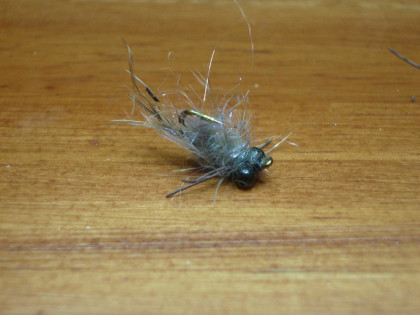Ever come across a tricky panfish bite under the ice? When fish get picky, ice flies are often the best solution for those nasty bites below the ice. This article gives a basic introduction to picking ice flies.

When picking an ice fly, there are three things that I consider. First, I think about what the fish is primarily feeding on, and how big that food source is. Panfish are opportunistic feeders, especially in the winter. They will feed on many things during the cold season. However, many of those food sources can be generalized into three categories: Nymphs and Larvae, Freshwater Shrimp, and Worms. As long as I have a couple from each category, I can match almost every bite.
Size is another key factor. Colder weather makes the fish have much smaller appetites. On those nasty days when your holes freeze over before you finish drilling them, a smaller fly is often the only way to entice a bite.
Finally, I consider triggers; does it have any? What are they? In the winter panfish have a much slower metabolism, so adding little triggers can help to entice the bite. During the cold months, panfish are not eager to chase an aggressive presentation. Triggers add little twitches of movement to a fly that is activated by minimal jigging, making triggers a crucial part of a fly. I love incorporating rubber legs and marabou into my flies. Rubber legs add beautiful movement even with the slightest twitch, and the marabou breathes under water. I also add a little flash to my flies. However, due to panfish’s lethargic nature during winter, adding too much flash will end up scaring the fish. Sometimes one extra trigger could mean the difference between being skunked and having a good day on the water.


Now that you have picked your fly its time to fish it. I prefer that my flies get down fast, so I rig my flies as a dropper to either a tungsten ice fly or a tungsten jig. If fishing with two hooks is not an option, I will fall back to a good ol’ drop shot rig or a single tungsten fly. Panfish under the ice have a much slower metabolism than in the summer, so I lean towards a gentle pattern of micro twitches. If the fish are too slow for a gentle jigging pattern, I’ll switch to barely moving the fly every few seconds. Any triggers will come into play here as the slightest twitch will make the flies move and look even more buggy. I always consider how the fish are reacting to my flies and jigging pattern, and I adjust accordingly.

Remember fish are lethargic in the winter so their appetite won’t be as large and they will be less aggressive. So, a smaller, more mellow fly is sometimes key. Ice flies are my favorite way to fish in the winter, and the perfect way to fish any bite.
Tight Lines,
Noah
Want some hand-tied ice flies? Check out our shop!


